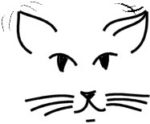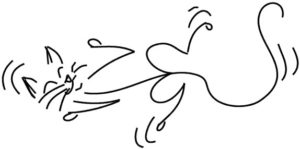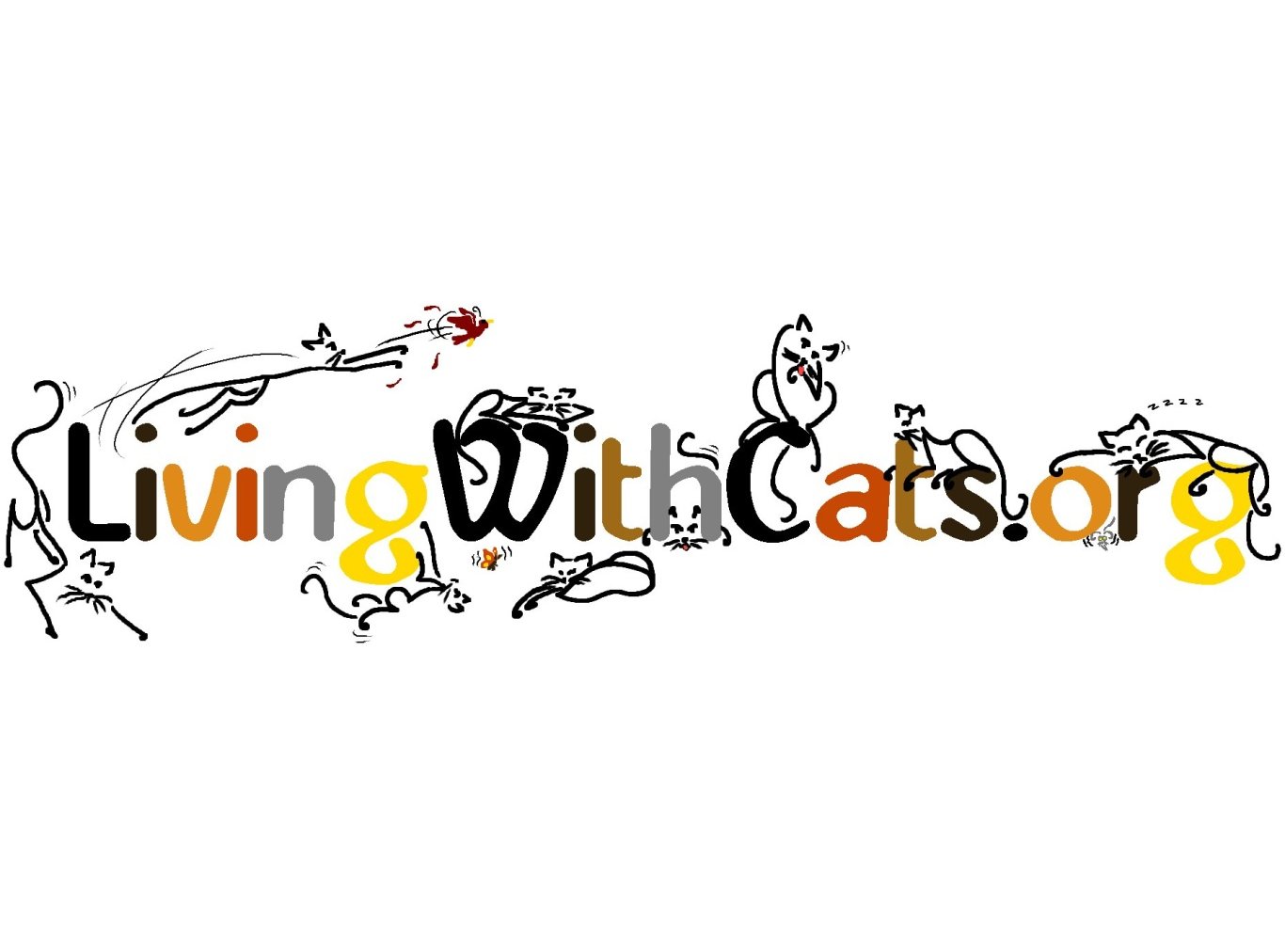 The cat is very intelligent. Cats are able to solve problems just like any other highly developed species. They are very good at knowing how to get what they want from us. Cats are masters in communication.
The cat is very intelligent. Cats are able to solve problems just like any other highly developed species. They are very good at knowing how to get what they want from us. Cats are masters in communication.
Cats communicate quite effectively minus any formally-structured language such as we have. Vocalizations, body language plus facial expressions all contribute to how they communicate with each other as well as with us. We can learn to understand many of these exchanges by carefully observing our cats. The more you are with your cat, the more you will begin to understand what she is saying to you. Cats are always open and honest and never hide their feelings as people tend to do.
NOTE: Were you aware that cats experience the same emotions, feelings, and needs that we do? Of all the animals, the cat’s brain is the only one that closely resembles the human brain. The brain of a cat is very similar in structure to the human brain. A cat has a cerebral cortex, parietal lobes, a cerebellum, a limbic system, a spinal cord, a thalamus, and a hypothalamus–the same basic brain structure as ours.
Treat your cat with love and respect and as an intelligent, thinking creature that is able to make choices, and your cat will respond in astonishing ways. Make your cat a definite part of your family, not just a pet.
Cat communication isn’t considered a language in the sense that a language requires an open system of meanings. A cat can express a few ideas with their vocalizations, but they can’t talk about the past, the future or about things that can never happen, like people can. A cat can tell you if she is hungry or wants to go out, but she cannot tell you about the great time she had yesterday engaging in interactive play with you or how much she is looking forward to doing it again tomorrow. Only a language can do this.
Researchers have concluded that cats use 9 consonants, 5 vowels, 2 diphthongs and one tripthong in their unique vocal communication. Meows, as a general rule, can stand for many things. They can be loud, soft, demanding, short, long, affectionate, angry or fearful. Meows can also express pain or disappointment. Most of the meows a cat makes are requests for your attention. The better your cat trains you to understand and respond to her meows, the more she will use them, and the richer her vocabulary will become.
Cats sometimes use a sweet, open-mouthed, silent meow. This seems to produce a quicker response from many of us. Naturally, when this happens, the cat is stimulated to use this silent meow more often. Did you know that it isn’t really a silent meow? Other cats can hear it. We can’t since it is too high of a pitch for our ears to register. Cats can detect sounds at a much higher frequency than we can–up to 50-65 kilohertz, as opposed to our limit of approximately 18-20 kilohertz.
Some cats are very talkative by nature, others seldom make a sound. Then there is the range between these two extremes–just as it is with people. Get to know your cat’s usual vocal patterns, and never ignore changes. If a usually silent cat becomes suddenly very vocal, she may be attempting to tell you something. Perhaps she is in pain or simply lonesome, bored or seeking extra attention. Your cat may be upset or confused if there has been a change in her life recently, such as if you’ve just moved to a new home, or acquired a new family member, or perhaps lost a family member or pet. If you have just installed new carpeting or added some new furniture, the unfamiliar odors of these items could be upsetting your cat. Be patient and give your cat time to adjust to the changes in her world. Maintain a positive and cheerful attitude. She will pick up your mood.
Some of the loudest, most dramatic feline sounds are the growls, wails, howls snarls, caterwauls, screams, and screeches of angry and fighting cats. These confrontational sounds will make your hair stand on end, but they are just extremely loud and dramatic sounding warnings that are meant to scare off an opponent. You will not soon forget these sounds once you have heard them.
A General Rule: Cats tend to become more talkative as they age.
Cats hiss to show annoyance. Hissing can also mean that your cat is afraid. A hissing cat means business and your best course of action would be to back-off. Attack is imminent. This is like an early defense warning system and it is always wise to heed it. Cats can do a lot of damage if they attack. If your cat hisses only when you touch a certain spot, she may be injured, and ill, or simply doesn’t like to be touched there. Depending upon the situation, hissing can also indicate pain or stress.
One of the sounds your cat makes is a rapid click-click chattering as she watches birds. The jaw vibrates rapidly, and the cat may softly squeak in excitement. Feline chattering is almost always in response to birds. Just watch your cat when she is looking out a window and sees some birds. Most likely she will make this rapid click-click chattering.
There are a variety of in-between mews and sounds a cat makes that you can learn to recognize if you closely study the behavior and situation when these sounds are made. Observation is how your cat learns to interpret and understand what you are trying to communicate to her. Such concepts as out, in, please, thank you, help, food, hungry, come here, and no can be easily interpreted by your cat. Cats seem to respond best to simple one or two-word concepts, though they can understand much more from the tone of your voice and your body language. If you use simple word commands consistently, your cat will respond well each time since she will understand what you want. For some reason, we have discovered that many cats will respond well to the words, “You’re welcome.” It seems to tell them it is okay.
It is good to talk to your cat. This will build her vocabulary. Cats can understand a large list of words. This needs to be an ongoing dialogue, not just once and a while. You will find that you will begin to understand your cat more and more as time goes by.
NOTE: Did you know that cats can learn to say some of our words like ‘in’ and ‘out’? Ours definitely do!
BODY LANGUAGE
It’s no accident that your cat holds her tail in a certain position, moves her ears and whiskers in a certain way, or tilts her head in an attempt to understand. Cats tell us a lot just by the way they carry themselves. Most of a cat’s ability to communicate comes from her body language but the message comes across loud and clear nonetheless.
Each cat has her own variation of body language, though some fundamentals remain unchanged from cat to cat. The rule of thumb here, as stated earlier, is to simply observe and learn how your cat responds to various happenings in her surroundings.
EYES![]()
Eyes can tell you more about a cat than any other factor. When assessing a cat’s general behavior, the eyes can be a dead giveaway as to what’s coming next.
Making Direct Eye Contact With Your Cat–Direct eye contact with a cat you do not know is not a good idea. That cat will interpret your stare as a sign of aggression and expect that you might even attack her. On the other hand, direct eye contact with a cat you know well can add a new dimension to your relationship with that cat. You’ll be able to know so much more about your cat and you’ll be able to communicate on a higher level with her.
 Wide-open eyes–Obviously the cat is alert and interested. Observe the difference between normal wide-open eyes and wide-open eyes that have a mischievous glint. The glint is a dead giveaway that your cat is up to no good.
Wide-open eyes–Obviously the cat is alert and interested. Observe the difference between normal wide-open eyes and wide-open eyes that have a mischievous glint. The glint is a dead giveaway that your cat is up to no good.
 Partially-Open or Half-Closed Eyes–This means the cat is relaxed. She trusts you. If half-closed eyes occur at times other than when your cat is nodding off, keep your own eyes open for signs of illness. There are times when your cat is sitting a distance from you and gives you a half-lidded slow blink. If you respond back with the same half-lidded slow blink you cat will do it back at you in acknowledgement, telling you she cares for you.
Partially-Open or Half-Closed Eyes–This means the cat is relaxed. She trusts you. If half-closed eyes occur at times other than when your cat is nodding off, keep your own eyes open for signs of illness. There are times when your cat is sitting a distance from you and gives you a half-lidded slow blink. If you respond back with the same half-lidded slow blink you cat will do it back at you in acknowledgement, telling you she cares for you.
NOTE: We have learned that we can direct our cats easily by moving our eyes from the cat to where we want the cat to move to. Of course, you must have your cat’s attention. The cat will follow your eye movements (which are usually accompanied by slight head motions). After a couple of times doing this, our cats will usually move to where we have indicated with our eyes. Naturally, being cats, this happens only when they can see an advantage in doing what we have requested with our eyes. The best response from them occurs when we are indicating the best way to reach our lap while avoiding another cat or two in their way.
 Closed Eyes–Your cat is asleep or close to it. This indicates that she trusts you completely and knows that you would never hurt her. Some cats snore! Snoring with closed eyes signifies total relaxation. We have several good snorers!
Closed Eyes–Your cat is asleep or close to it. This indicates that she trusts you completely and knows that you would never hurt her. Some cats snore! Snoring with closed eyes signifies total relaxation. We have several good snorers!
 Dilated and Enlarged Pupils vs. Contracted Pupil Slits–Both enlarged pupils and pupils that seem to close up into the smallest slits can be indicative of pending aggression. Sometimes the slits reflect a feeling of being threatened. On the other hand, when the cat’s the aggressor, instigating the situation, the pupils are usually enlarged or dilated. Be cautious and handle her with care until you know exactly what she means.
Dilated and Enlarged Pupils vs. Contracted Pupil Slits–Both enlarged pupils and pupils that seem to close up into the smallest slits can be indicative of pending aggression. Sometimes the slits reflect a feeling of being threatened. On the other hand, when the cat’s the aggressor, instigating the situation, the pupils are usually enlarged or dilated. Be cautious and handle her with care until you know exactly what she means.
A large, round-looking pupil can also simply indicate excitement like receiving her food dish. Dilated pupils mean that the cat has a strong feeling about something. You will have to assess her surroundings in order to interpret whether the dilated eyes are showing anticipation or fear. You also need to note the intensity of light–if it is dim, the cat’s eyes will dilate so as to allow more light to enter so she can see better.
Narrow pupil slits may mean that your cat is focusing intensely on something of interest. Slit eyes can also simply mean that the light is too bright.
NOTE: The cells in a cat’s eye consist of two kinds (same as us)–rods and cones. The rods respond to very low levels of light and don’t distinguish between colors. The cones need a higher level of light and come in different varieties to respond to the different color hues. Compared to us, cats have few cones but many rods. A cat can see color, but not as vivid as we do. Research has shown that they see blue and yellow better than red and green, but color does not seem to hold much importance to them.
THE MOUTH
The mouth is either relaxed in a comfortable position, uttering normal meows, or displaying some form of open-mouthed, raised-lip warning. Usually, the higher the lip is raised or curled, the greater the degree of aggression being displayed. Any curled lip should be taken seriously. When the cat is relaxed, the mouth is also relaxed. The lips are in a normal position.
There is also a peculiar scenting behavior that cats have in common with many other mammals, called the “Flehmen response” where the cat curls back her upper lip to expose her front teeth, inhales, and holds this position for several seconds. It will be done over a site or object of interest, such as urine markings or feces, or with the neck stretched and head held high to “scent the air”. This action transfers pheromones and scents to the vomeronasal organ (or Jacobsen’s organ), which is located between the roof of the mouth and the palate, by way of a duct just behind the front teeth. Males will use this organ to determine if nearby females are ready to mate.
 For health reasons watch for any excessive pawing or rubbing of the mouth and face areas. This is how you may be able to tell if your cat has a toothache, ear ache, or something is her eye.
For health reasons watch for any excessive pawing or rubbing of the mouth and face areas. This is how you may be able to tell if your cat has a toothache, ear ache, or something is her eye.
Did you know that cats smile when they are happy?
THE WHISKERS
It is very important that you NEVER TRIM your cat’s whiskers. They are very valuable to a cat. They enable her to identify her surroundings thus allowing the cat to move through her world with confidence.
A cat’s whiskers will give you some insight into what her mood is.
Happy cats keep their whiskers outwardly extended from the mouth area. If the whiskers are either pulled back tight against the face or are bristling, WATCH OUT. Your cat is not a happy camper. Aggression or fear (which could quickly turn into aggression) is taking place. Aggressive behavior, like biting or striking out, could occur with lightning speed.
Pulled-back whiskers could also mean that your cat isn’t feeling well, if they remain pulled-back for a prolonged period of time. Check with your veterinarian.
NOTE: A cat’s whiskers are a specialized -type of hair. They are referred to as vilrissae (also called tactile hairs) or sinus hairs, and are located on a cat’s eyebrows, chin, cheeks and in an area behind the forelegs, above the paw. Whiskers are long and still, yet flexible. They are two to three times thicker than other hairs and taper to a fine, flexible tip. Approximately twelve of these stiff whiskers align in four rows that protrude from either side of the cat’s muzzle. The top row moves independently of the middle row. The base of each whisker is deep in the skin (the root is embedded three times deeper than the cat’s hair) and is surrounded by many nerve endings. The end of a cat’s whiskers is a sensory organ (called a proprioceptor) that sends a message to the cat in response to stimuli. These nerve endings alert the cat to the slightest vibration or any contact with the hair. The whiskers efficiently detect anything from the shape and size of a narrow opening to shifts in the wind and even changes in the barometric pressure. They even protect the cat’s eyes from injury by providing a startle reflex that shuts the cat’s eyes if anything touches them. A cat’s whiskers grow in proportion to her body size, and are shed periodically.
A cat uses her whiskers to tell her whether she will fit into, under or next to an object or in a space. While hunting, they tell the cat the shape of the prey and how it is moving. The facial whiskers help determine the bite point on a prey’s neck. Whiskers located on the forelegs collect information about captured prey. Since a cat is far-sighted, she often cannot see prey in her clutches. The leg whiskers allow the cat to estimate size, shape, and position of the prey, as well as the cat’s own position in relation to it. These whiskers also help to detect escape attempts by the prey. The whiskers are the main reason why cats can see so well in the dark, since they enable the cat to sense the size and shapes of all obstacles and spaces without needing to see or touch them first.
Whiskers have another important function in that they assist the cat in detecting odors.
THE EARS
 The cat’s ears can indicate her mood and purpose and are good tools for interpreting body language quickly. A cat’s ears are extremely sensitive and able to hear a much wider range of sounds than our ears. This is why cats hate noisy homes, loud music, screaming, and shouting. At the lower levels of sound, there is little difference between us, dogs, and cats. At the higher levels, we can hear noises up to 20,000 cycles per second. Dogs hear at around 35,000 to 40,000 cycles per second. Cats go far beyond this. They can hear up to 100,000 cycles per second! This corresponds to the high pitch mice make.
The cat’s ears can indicate her mood and purpose and are good tools for interpreting body language quickly. A cat’s ears are extremely sensitive and able to hear a much wider range of sounds than our ears. This is why cats hate noisy homes, loud music, screaming, and shouting. At the lower levels of sound, there is little difference between us, dogs, and cats. At the higher levels, we can hear noises up to 20,000 cycles per second. Dogs hear at around 35,000 to 40,000 cycles per second. Cats go far beyond this. They can hear up to 100,000 cycles per second! This corresponds to the high pitch mice make.
 A cat who is relaxed will hold her ears in an alert position and will move them a little while changing direction as they pick up on sounds all around. The ears are usually rotated forward.
A cat who is relaxed will hold her ears in an alert position and will move them a little while changing direction as they pick up on sounds all around. The ears are usually rotated forward.
 A submissive or fearful cat will pull her ears back and flat against the head. They’re in a perfect position to show that the cat would just as soon give in rather than fight. When attacked, the cat pulls her ears back to lessen the chance of an ear being grabbed, bitten, or damaged. Don’t be fooled by submissive ears. If the cat feels sufficiently challenged, a fearful submissive cat is very capable of shifting gears and attacking for her own preservation.
A submissive or fearful cat will pull her ears back and flat against the head. They’re in a perfect position to show that the cat would just as soon give in rather than fight. When attacked, the cat pulls her ears back to lessen the chance of an ear being grabbed, bitten, or damaged. Don’t be fooled by submissive ears. If the cat feels sufficiently challenged, a fearful submissive cat is very capable of shifting gears and attacking for her own preservation.
 A completely aggressive cat will usually hold her ears out of their normal position but not quite flat against the head. They’re often somewhat rotated so that a portion of the back of the ear is almost facing forward, like the wings of a plane. This ear position says that the cat is ready for whatever comes her way and that she is not going to be scared off.
A completely aggressive cat will usually hold her ears out of their normal position but not quite flat against the head. They’re often somewhat rotated so that a portion of the back of the ear is almost facing forward, like the wings of a plane. This ear position says that the cat is ready for whatever comes her way and that she is not going to be scared off.
Twitching ears are displayed by some cats to indicate an emotional extreme. This could mean anything –delight, submission, aggression or frustration. It could also indicate that your cat has an ear problem, like ear mites–see your veterinarian.
Cats that don’t feel well may pull their ears in various positions depending on the degree of physical pain and upset. Usually, the more pulled back the ears, the greater the pain or upset.
Cats can perceive more sounds than we can. We can detect 8.5 octaves while a cat can detect 10. They can hear the ultrasonic calls of rodents as well as their kittens. There is one set-back in their hearing abilities. Cats can only discriminate between sounds that are at least 5 degrees apart, while we can distinguish sounds that are only 0.5 degrees apart. When 2 sounds occur close together in front of us, we can hear 2 distinct sounds where a cat cannot. A cat’s external ears, which funnel sounds down to her eardrums, enable her to hear as well as she does.
 THE TAIL
THE TAIL
A cat’s tail not only provides her with balance, its movements can help us to understand what is going on in her mind. Tail movement is an important part of a cat’s body language and mood. As the tail position lowers, so does the cat’s mood. A horizontal tail position may mean she is stressed or unsure of herself, and if it drags on the ground she may be unhappy or even sick.
 When your cat walks with her tail erect, not bristled and waving back and forth, she is showing you she is willing to interact.
When your cat walks with her tail erect, not bristled and waving back and forth, she is showing you she is willing to interact.
 When two cats pass each other, they will raise their tails up straight into the air as an acknowledgement of each other. This tail position can also be observed when a cat approaches a person she knows. It is a friendly gesture.
When two cats pass each other, they will raise their tails up straight into the air as an acknowledgement of each other. This tail position can also be observed when a cat approaches a person she knows. It is a friendly gesture.
 Happy tails can take a few postures. One posture is neither up nor down, nor swishing or moving, but just hanging there at a 45-degree angle and tells you that the cat is relaxed and feeling comfortable with the world around her. She is in a neutral yet interested mood.
Happy tails can take a few postures. One posture is neither up nor down, nor swishing or moving, but just hanging there at a 45-degree angle and tells you that the cat is relaxed and feeling comfortable with the world around her. She is in a neutral yet interested mood.
Another happy tail position is when the tail is held erect, directly over the cat’s rear end, and is sometimes combined with a certain quivering motion. For anyone who has witnessed a spraying cat, this is the same tail position for spraying and marking territory. (It looks the same, but this time, no spray is emitted). The same tail posture can be seen in cats that are happily excited about other things, particularly feeding time.
Have you ever noticed that a cat’s tail will oftentimes become erect while you are petting her? This is a warm gesture. Your cat is showing you that she is happy and confident. She is also exposing her anal glands for you to sniff! It means she really likes you. Just continue to stroke her. Fortunately that will be enough!
When the cat’s tail resembles a question mark with the tail fairly straight up and the tip of the tail is to one side, your cat is in a playful mood.
Aggressive tails are crucial to recognize. It is important to understand that aggressive tails can also be fearful tails. Remember that the cat, if sufficiently frightened or threatened, might attack. Hence, aggressive and frightened tails have the same body language. A cat can do a lot of damage to you with her very sharp claws and teeth, so it is important to recognize when you should back off and leave her alone.
 Tails that thump or swish from side to side (like a whip) are signs to look out for. This is definitely not a sigh of friendliness. Usually the faster the tail swishes or thumps, the greater the degree of the cat’s agitation. Cats do not wag their tails in happy displays the way dogs do. When the cat’s tail is held still with only the tip twitching, she is mildly irritated. If the tip twitching becomes more pronounced as it continues–watch out! The cat is becoming angry.
Tails that thump or swish from side to side (like a whip) are signs to look out for. This is definitely not a sigh of friendliness. Usually the faster the tail swishes or thumps, the greater the degree of the cat’s agitation. Cats do not wag their tails in happy displays the way dogs do. When the cat’s tail is held still with only the tip twitching, she is mildly irritated. If the tip twitching becomes more pronounced as it continues–watch out! The cat is becoming angry.
 Bristling tails held in an upright, arched, or curved position are other fairly obvious signs of uncertain behavior that could be coming next. The key here is to watch for bristling fur on the cat’s body. Sometimes a cat who is very excited over your attention will bristle the hair at the base of her tail as well as on it. This cat will demonstrate her desire for more attention from you, sometimes by making little kitten calls and purring. The body language and the type of vocalization is the key here. If the bristling is accompanied by hissing and/or growls, back-off or you might end up injured.
Bristling tails held in an upright, arched, or curved position are other fairly obvious signs of uncertain behavior that could be coming next. The key here is to watch for bristling fur on the cat’s body. Sometimes a cat who is very excited over your attention will bristle the hair at the base of her tail as well as on it. This cat will demonstrate her desire for more attention from you, sometimes by making little kitten calls and purring. The body language and the type of vocalization is the key here. If the bristling is accompanied by hissing and/or growls, back-off or you might end up injured.
A tail which swishes very slightly from side to side signifies a cat that is focused and intensely interested in something. If the swishing from side to side is very quick, the cat is extremely focused and perhaps, stalking prey.
 Submissive tails will be lowered between the cat’s legs, curled against her body. Submissive cats may also thump their tails as they move them back and forth. The most submissive, frightened cat will fold her tail between her legs and curl her body up into a ball, possibly even whimpering and cringing. Do not attempt to handle this cat. Her submissiveness could quickly turn into painful bites and clawing if she attempts to escape from you.
Submissive tails will be lowered between the cat’s legs, curled against her body. Submissive cats may also thump their tails as they move them back and forth. The most submissive, frightened cat will fold her tail between her legs and curl her body up into a ball, possibly even whimpering and cringing. Do not attempt to handle this cat. Her submissiveness could quickly turn into painful bites and clawing if she attempts to escape from you.
Inquisitive tails are raised up a bit but maintained in a normal, gently curved position.
When a female cat (who has not been spayed) holds her tail over to one side, it is a sure sign that she is in heat. This is a sexual invitation to the male.
Sick cats will often hold their tails in one of the submissive positions. Often, the more submissive the tail position, the more pain or illness the cat is experiencing.
A Cat’s Fur And Coat is another way she can communicate what she is feeling. When scared, angry or excited, the guard hairs all over the cat’s coat, especially along her spine–will puff-out, thus making her look larger and more fearsome. If she is really excited, her tail will bush out like a fat brush. Sometimes, when a cat is excited over seeing you, her tail will bush, but her body hairs will not. When a cat is ill or not feeling well, her coat will appear dull and kind of rumpled, and also somewhat bushed. A visit to your veterinarian could be in order.
Posture is an important means of communication. When the cat wishes to look large, threatening, and formidable, she will stand sideways, on tiptoe, with her back arched, and her tail curved and possibly twitching (like a Halloween cat).
When she’s approaching an unknown or dominant cat, she will try to minimize her presence by slinking or crouching low, and lowering her ears, eyes, and tail.
When she’s feeling happy and confident, she will prance tall with her ears up, her tail raised, and her head held high.
 Stretching, Yawning, and Rolling Over on the Back–This posturing shows that your cat is comfortable enough to be relaxed with you and is exposing the most vulnerable part of her body, the belly. Just remember, she may not be fully prepared to allow you to touch her there. Some cats love their bellies rubbed, others simply will not tolerate it and will kick at your hand roughly with their hind feet and sometimes even bite your hand. If your cat allows you to rub her belly, watch your cat’s ears, eyes and whiskers for clues that she has had enough and STOP. If she should suddenly claw and bite, don’t pull your hand away since her instinct will be to grab on harder. Instead, stop all movement and try to distract her long enough to defuse the situation and allow you to remove your hand safely. Let her calm down for a while before resuming any contact and let her make the first move.
Stretching, Yawning, and Rolling Over on the Back–This posturing shows that your cat is comfortable enough to be relaxed with you and is exposing the most vulnerable part of her body, the belly. Just remember, she may not be fully prepared to allow you to touch her there. Some cats love their bellies rubbed, others simply will not tolerate it and will kick at your hand roughly with their hind feet and sometimes even bite your hand. If your cat allows you to rub her belly, watch your cat’s ears, eyes and whiskers for clues that she has had enough and STOP. If she should suddenly claw and bite, don’t pull your hand away since her instinct will be to grab on harder. Instead, stop all movement and try to distract her long enough to defuse the situation and allow you to remove your hand safely. Let her calm down for a while before resuming any contact and let her make the first move.
 Bumping Heads and Rubbing Noses–Take this as a compliment. Whether your cat is distributing her scent on you or simply making close personal contact, only the cat will ever really know. Just interpret this as a sign of affection. Your cat has accepted you into her social circle, so accept it as a gesture of caring.
Bumping Heads and Rubbing Noses–Take this as a compliment. Whether your cat is distributing her scent on you or simply making close personal contact, only the cat will ever really know. Just interpret this as a sign of affection. Your cat has accepted you into her social circle, so accept it as a gesture of caring.
 Licking–If your cat develops an obsession with licking a specific spot on her body, it’s often her way of telling you there’s pain or a problem in that area. Have your veterinarian check it out.
Licking–If your cat develops an obsession with licking a specific spot on her body, it’s often her way of telling you there’s pain or a problem in that area. Have your veterinarian check it out.
Cats will sometimes lick you as a gesture of friendship. Cats will groom each other when they are friends. Your cat is extending this friendship to you. Don’t reject it by pushing her away.
Cats will also groom themselves when they are uncomfortable. The cat’s discomfort will be obvious. This grooming is different from regular grooming in that it is more vigorously done and does not continue for very long. She will lick a paw or her tail until the discomfort and confusion are resolved or she feels more confident. Some cats will groom excessively to the extent of creating bald spots, particularly on their legs and belly. Check with your veterinarian. Skin mites, allergies or even an emotional problem may exist. Your veterinarian can determine the cause and correct the problem.
 NOTE: By being a good observer of your cat’s body language and what is happening around her, you will learn to understand what she is trying to say to you. You will soon see that certain vocalizations are done at the same pitch, length, and intensity consistently at specific times and places. You can even learn to imitate these sounds and have a rough understanding of what they mean to your cat. It’s fun to copy the sounds your cat makes. Most cats like you to do this and will become more talkative. Every time you make a cat sound, they will usually respond back.
NOTE: By being a good observer of your cat’s body language and what is happening around her, you will learn to understand what she is trying to say to you. You will soon see that certain vocalizations are done at the same pitch, length, and intensity consistently at specific times and places. You can even learn to imitate these sounds and have a rough understanding of what they mean to your cat. It’s fun to copy the sounds your cat makes. Most cats like you to do this and will become more talkative. Every time you make a cat sound, they will usually respond back.
WHY A CAT PURRS
Everybody loves to hear a cat purr. Cats purr for a variety of reasons. A cat who is contented, happy, furious, or in pain, purrs. Badly injured and dying cats often purr. A cat about to give birth purrs during her labor with continuous, powerful, rhythmic purrs. (Kittens begin to purr when they are about two days old.) Observe what is happening around the cat when she is purring to determine why she is purring.
Many cats will purr in anticipation of something they think they are going to get–food, interactive-play, or simply attention. A purr tells you that the cat is having a wonderful time.
A purring mother cat is allowing her kittens to feel the vibration of her purr. Tiny, defenseless, newborn kittens, having no eyesight and poor senses of smell and hearing, use the vibrations from the mother’s purring as a homing device. A purring kitten lets the mother know that she is nursing successfully. A kitten can purr long before her eyes open.
Among adult cats, a subordinate cat will oftentimes purr to appease a more dominant one. It probably helps to reduce the chances of an attack by the aggressor cat.
If your cat’s ears are flattened against her head, the pupils of her eyes are dilated, and the body is tense, yet your cat is purring, know that she is very frightened and not at all happy.
As stated earlier, cats purr for a variety of reasons. When combined with what is happening around the cat at the same time, purring may be indicative of the cat’s intent and exactly what she may have on her mind at that moment.
KNEADING
 Kneading happens when the cat is relaxed and happy. She will lift one paw, then press it back down, and then repeat this motion with the other paw, over and over again in a rhythmic pattern. Some cats will even drool a little! Sometimes this rhythmic pattern is called, “making bread”. The cat is reliving memories of her kittenhood–where this kneading was an important part of nursing. The kneading told the mother that the kitten was getting milk and it also encouraged her body to release the milk flow. Kneading is the ultimate sign of affection. This is a good reason to keep your cat’s claws trimmed since most cats extend their claws when kneading, this could prove to be painful to you. You can also cover your lap with a lap robe or heavy sweatshirt to protect yourself from her claws. Some cats simply do not use their claws when they knead. We have a couple of them.
Kneading happens when the cat is relaxed and happy. She will lift one paw, then press it back down, and then repeat this motion with the other paw, over and over again in a rhythmic pattern. Some cats will even drool a little! Sometimes this rhythmic pattern is called, “making bread”. The cat is reliving memories of her kittenhood–where this kneading was an important part of nursing. The kneading told the mother that the kitten was getting milk and it also encouraged her body to release the milk flow. Kneading is the ultimate sign of affection. This is a good reason to keep your cat’s claws trimmed since most cats extend their claws when kneading, this could prove to be painful to you. You can also cover your lap with a lap robe or heavy sweatshirt to protect yourself from her claws. Some cats simply do not use their claws when they knead. We have a couple of them.
1-28-2017bct


